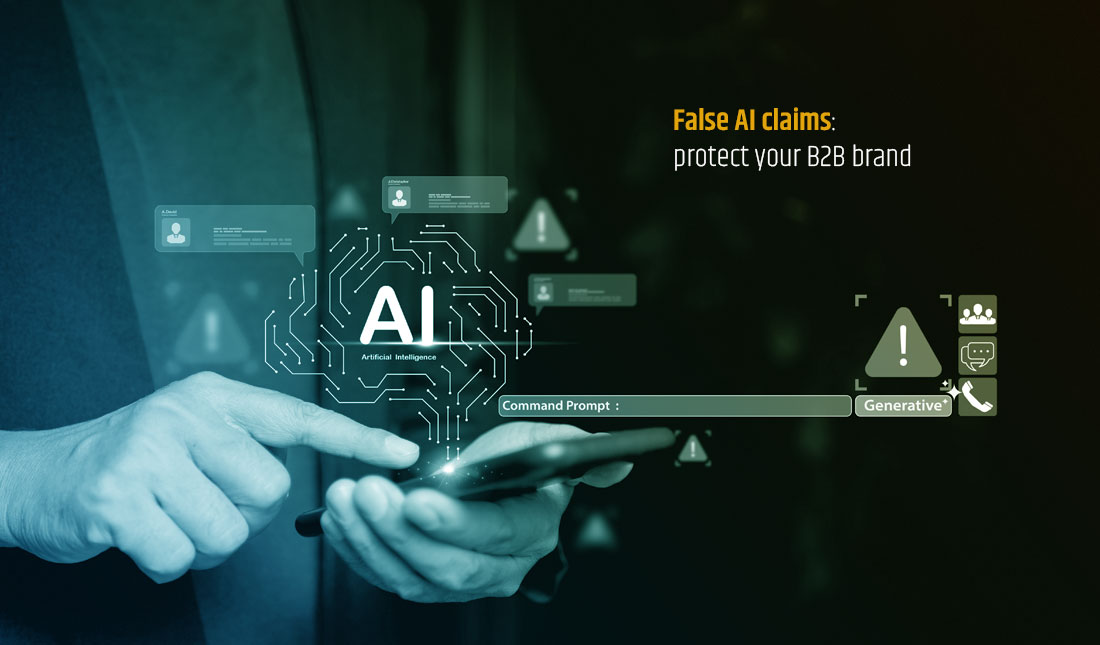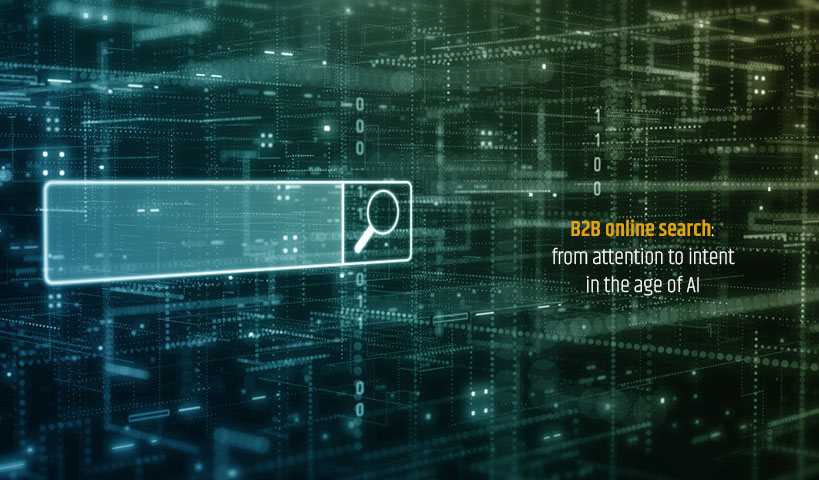
Have you ever asked a conversational agent or chatbot a question about a company… only to get an answer that was completely off track? You’re not alone. These errors are far from trivial. They can seriously damage a brand, especially in B2B, where trust takes time to build but can vanish in an instant. False AI claims are multiplying.
Outdated information, plausible inventions, or simply inaccurate data and if these responses begin circulating in your company’s name, your reputation and business relationships may pay the price. In a world where decision-makers increasingly turn to conversational engines for information, understanding and preventing these distortions has become a strategic imperative. It’s the only way to avoid the false AI statements that now threaten B2B brands.
How false AI claims can distort your B2B brand image
Generative artificial intelligence is now everywhere in B2B: automated newsletters, search engines, customer-service chatbots, prospecting tools, and support platforms. Yet behind this apparent efficiency lies an uncomfortable reality. These systems aren’t always right.
A language model, even a sophisticated one, doesn’t truly understand your offers or promises. It predicts words. It guesses answers. When it can’t find the correct information, it fills the gap with something that sounds credible but isn’t. That’s what we call a hallucination.
Model biases: hallucinations, cultural context, and B2B language
Language models are powerful, but they learn from massive volumes of text scraped from the Web, a space largely English-speaking and consumer-oriented. Their answers often reflect cultural, linguistic, or contextual biases that don’t align with the reality of Québec’s B2B, industrial, or technical markets.
These biases grow stronger when the model tries to fill information gaps: it “hallucinates” a plausible but false answer to preserve conversational flow. In B2B marketing, where every technical term or sector has its own vocabulary, these approximations can distort the very meaning of your offer or positioning.
Understanding these biases means recognizing that AI doesn’t make random mistakes. It reproduces the blind spots in its training data. That’s why human oversight and a structured brand language are so important: they provide reliable anchors when AI “speaks” about you.
In B2B, this drift can have serious consequences. Imagine a conversationnal agent telling a potential client that your service is available only in certain regions. Or that an AI engine claims you work exclusively with a specific industry. In a single answer, you lose a business opportunity and might never even know it happened.
False AI claims don’t stop at your internal tools. They also seep into large public models like ChatGPT, Gemini, or Perplexity, which draw their answers from a mix of outdated data and Web content of uneven quality. A rumor or error online can easily become an algorithmic “truth.”
When false AI claims become a business risk
In B2B, trust is a rare currency. Every interaction influences a long, complex, and often costly sales cycle. When a virtual assistant or AI engine makes a mistake, the potential client doesn’t question the tool. They question your professionalism.
Such errors quickly turn into a business risk. They can distort the perception of your expertise, blur your brand messages, and plant seeds of doubt in decision-makers’ minds. In some cases, they can even create legal exposure if AI promises guarantees, certifications, or deliverables you don’t actually offer.
Recent examples show B2B companies forced to issue public corrections after chatbots spread false product information. Others discovered that their official contact details had been replaced in AI-generated responses.
As B2B buyers turn toward conversational search, false AI claims become a new point of strategic vulnerability. In an environment where 80% of the buying journey occurs before any contact with a representative, every AI-generated word matters.
Why false AI claims occur: technical and human limits
False AI claims rarely stem from malice. They arise from technical and organizational limitations.
First, language models aren’t connected to your systems in real time. They learn from static, historical data. The result? New offers, updated pricing, and recent studies aren’t reflected in their knowledge base.
Second, many B2B companies underestimate the complexity of their own language. Industrial products, IT services, integrated solutions, all demand terminological precision. A general-purpose AI interprets what it reads, without sector-specific nuance.
Finally, too many organizations deploy chatbots without marketing supervision or linguistic governance. The result: an inconsistent brand voice, unsynchronized data, and a tone that feels off-key for business relationships.
“In B2B marketing, where credibility is the foundation of the client relationship, false AI claims can quickly become a major irritant.”
How to prevent false AI claims
Preventing false AI claims starts with a simple principle: regain control of your brand language.
Begin by auditing your public content, website, technical sheets, FAQs, press releases, case studies. These are the materials AI reads and reproduces. Every outdated piece of information is a potential source of error.
Then, structure your content to be readable not only by humans but also by language models. In traditional SEO, you optimize for Google. In LMO (Language Model Optimization), you optimize for generative AIs. This means crafting explicit answers, using simple formulations, and maintaining consistent terminology.
Implement content governance. In B2B, information flows between departments, sales, marketing, service, technical. If each communicates its own version, AI will replicate that confusion. Linguistic coherence must become a shared responsibility.
Finally, test your internal tools. Ask the same questions your prospects would. If the AI gives poor answers, that’s your cue to adjust databases or public content. Monitoring must be continuous, because AI itself learns continuously.
ExoB2B and brand language optimization in the age of AI
At ExoB2B, we’ve been helping B2B companies navigate digital transformation for over twenty years. Today, that transformation also means taking control of your algorithmic voice.
Our approach to Language Model Optimization (LMO) ensures that AI systems can understand, interpret, and accurately relay your company’s strategic information.
In practice, this means:
– Writing content that language models can properly interpret.
– Standardizing your messages across all channels.
– Building a content architecture that reinforces your brand’s perceived reliability.
Combined with SEO and GEO (Generative Engine Optimization), LMO acts as a reputational shield. It ensures that your verified information outweighs the approximations or inaccuracies circulating through external models.
In a world where the first impression often comes from an AI engine, it’s no longer just about looking good. It’s about being accurately represented.
Toward a new B2B brand responsibility
In B2B, every word carries weight. As AI begins to speak on behalf of companies, it reshapes that responsibility. You are no longer accountable only for what you say, but also for what AI says about you.
This demands close collaboration among marketing, IT, and sales teams. Content must be synchronized, data validated, and responses calibrated to reflect your company’s tone and positioning.
Yet this vigilance is also an opportunity. By mastering how AI describes your expertise, you directly shape how your markets perceive your brand. You transform technology into a strategic lever for credibility.
The future of B2B marketing will not be purely human or purely technological, it will be hybrid. An alliance between the precision of content and the intelligence of models.
Conclusion
False AI claims are not just a technological annoyance, they now represent a major reputational risk for B2B organizations. Invisible at first, they can distort buying decisions, damage business relationships, and erode hard-earned trust.
But this risk is manageable. By structuring your content ecosystem, adopting an LMO strategy, and maintaining strong brand-language governance, you can turn AI into a trusted partner.
At ExoB2B, we help companies stay in control of their message, whether human, digital, or generative. Because in the age of artificial intelligence, your credibility depends on what AI says… and how precisely it says it.
Want to know how your brand is perceived and interpreted by AI? Our augmented SEO experts can help you diagnose and correct gaps between your intended message and what generative models are saying about you. Contact us.
FAQ
1. How can I detect false AI claims in a B2B context?
Test your chatbot the way a client would. Vague or contradictory answers often reveal false AI claims.
2. What should I do if false AI claims circulate on ChatGPT or elsewhere?
Report the error to the platform and publish an official correction. Transparency limits the impact of false AI claims.
3. Can LMO fix false AI claims?
Yes, partially. Structuring your content through Language Model Optimization reduces the likelihood of false AI claims.
4. How can false AI claims harm a B2B sale?
A single wrong answer can turn a prospect away before any contact. False AI claims break trust at the very first step.
5. Are false AI claims inevitable?
No. A rigorous content strategy and continuous monitoring prevent most false AI claims.
Author’s note:
This post was written with the help of ChatGPT (OpenAI). I wanted to explore how far AI could accompany me in reflecting on… itself. The text, ideas, and final tone were entirely reviewed, refined, and assumed by a very real human: me.




